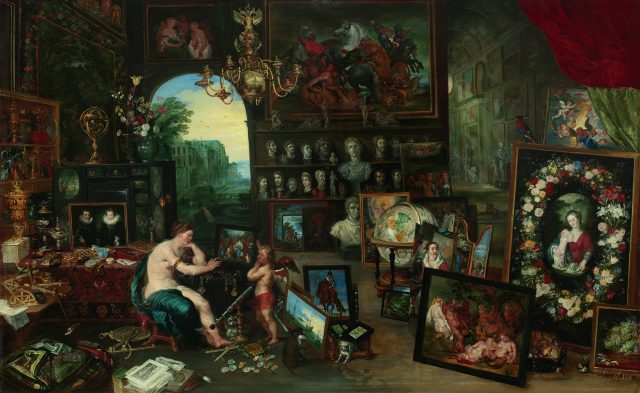Fall 2016
Seeing Nature
A NOMA exhibit explores the subject of landscape through an impressive range of styles and time periods from the 17th through 19th centuries in Europe
Published: September 6, 2016
Last Updated: October 19, 2018
The fall exhibition at the New Orleans Museum of Art explores the subject of landscape through an impressive range of styles and time periods from the 17th through 19th centuries in Europe, and the 19th and 20th centuries in America. On view from Oct. 14, 2016 to Jan. 15, 2017, Seeing Nature: Landscape Masterworks from the Paul G. Allen Family Collection consists of 39 masterpieces from the collection of Paul Allen, Microsoft co-founder and philanthropist. The exhibition includes exemplary works by Jan Brueghel the Younger, J.M.W. Turner, John Singer Sargent, Paul Cézanne, Claude Monet, Georgia O’Keeffe, David Hockney and Gerard Richter.
The experience of the world through perception is the subject of Jan Brueghel the Younger’s allegories of the five senses, which serve to ground and introduce the exhibition. Jan the Younger followed the signature style of his father — known as “Velvet” Brueghel — and was known to paint copious flowers and greenery and lush fabrics and textures to epitomize sensuality. In the panel devoted to smell, a lounging Venus holds a flower to her nose, which she has plucked from the bouquet Cupid has brought her. The arbor she sits in is meticulously painted with hundreds of flowers that can only be brought together through art, as they all bloom in different seasons. The resplendent luxury of sensual experience reflects the courtly sphere Breughel worked in, which is also indicated by the royal residence in the left background.
Impressionist and post-impressionist works form the centerpiece of the exhibition. In addition to six works by Monet and paintings by Cézanne and Signac, a high point of the show is the Birch Forest by Monet’s younger contemporary, Gustav Klimt. The wooded landscape is structured through the patterns of the forest floor: of the wood, the leaves and the mossy tree trunks. The effect is jewel-like and flat. The glistening leaves painted in gold highlights create a rhythmic tension with the two dimensional, dry birch tree trunks. This exceptional painting offers a rare view of Klimt, who was better known for his society portraits made in Vienna. The artist turned to landscape in his final years and concentrated his energies on studies of the Attersee Lake and its surrounding forest in lower Austria.
Venice features prominently in this collection of paintings. Nine works by Canaletto, Turner, Manet and Moran expound the glory and mystery of the city. Together, the group investigates the unique quality of light as part of the experience of the city and its canals. Joseph Mallord William Turner was captivated by Venice. He made numerous trips in the 1830s and made over 30 paintings of the city. Made during his final trip, Turner’s “1841 Depositing of John Bellini’s Three Pictures” is a tour de force of painting emotion and mood. Throughout his career, Turner traveled the continent extensively and his work focused exclusively on city-, sea- and landscape painting, often worked up from watercolor sheets done on site. This canvas exemplifies the increasing abstraction of his later work where diffused light, blurred vision and bleeding colors achieve a distinctive, seemingly intuitive performance that is highly personal and dramatic.

Grand Canyon of Arizona at Sunset, painted in 1909 by Thomas Moran. Courtesy of the New Orleans Museum of Art, Paul G. Allen Collection.
Thomas Moran made the Grand Canyon the main subject of his art for over 30 years. He first encountered the landmark in 1873 and continued to explore its endless compositional potential, creating paintings that single-handedly sparked tourism to the site. The exhibition’s Grand Canyon presents an aerial vista hovering just below the Canyon’s rim, situating the viewer below the clouds and in the canyon on the rocky outcropping of the composition’s right side. The sense of place and awe achieved matches the experience of this natural wonder. This late painting of 1909 was made three years after Theodore Roosevelt designated the Grand Canyon a national monument. It offers an important example of the way the tradition of American grand landscapes of the 19th century’s last quarter reflected and played a role in the fulfillment of manifest destiny.
The exhibition’s ranging view of landscape offers a remarkable opportunity to consider the meaning and role of landscape and art. Above all, the selected works pay homage to the individual experience of place balanced by the universal role of landscape in human experience.
This exhibition is co-organized by Portland Art Museum, the Seattle Art Museum and the Paul G. Allen Family Collection.
—-
Vanessa Schmid, Senior Research Curator for European Art


